
Worst to first: A post-NFL Draft ranking of skill-position groups
The draft equipped every team with new skill-position components, affecting most franchises' depth charts. Here is how the league's wide receiver, tight end and running back groups stack up going into the offseason, from worst to first.
32. Washington Redskins
Washington found a gem in 2019 third-rounder Terry McLaurin, but its projected receiver room lacks depth. The player who could supply it, third-rounder Antonio Gibson, may be a running back. The Memphis product scored seven 40-plus-yard TDs in 2019 and as of now is a hybrid player. Adrian Peterson will try to become the fifth 15,000-yard rusher; he's 784 away. Talented but injury-riddled backfield partner Derrius Guice may be nearly out of time now that a new regime is in place. Unless you’re in a 20-team fantasy league, the Redskins have no tight ends of note.
31. Miami Dolphins
The veterans the Dolphins added on the offensive line -– guard Ereck Flowers and center Ted Karras -– do not inspire confidence running lanes will be consistent for Jordan Howard and trade acquisition Matt Breida. Miami persuaded DeVante Parker to take a team-friendly deal but does not have too much around him. Promising undrafted free agent WR Preston Williams’ ACL tear may limit his 2020 contributions. Third-year tight end Mike Gesicki’s jump from 202 yards to 570 in Year 2 may make him the non-Tua Tagovailoa player to watch in this offense. This is still a rebuilding team.
30. New England Patriots
Not only did the Patriots not draft a quarterback, they did not select a wideout or running back. Julian Edelman will turn 34 in May, and 2019 first-rounder N’Keal Harry is basically coming off a medical redshirt season. The Pats gave up their second-rounder for long-coveted Mohamed Sanu, who posted 207 yards receiving in eight games.
New England did draft two tight ends –- UCLA’s Devin Asiasi and Virginia Tech’s Dalton Keene -– in Round 3 but otherwise has the same skill-position contingent. RB Sony Michel has not lived up to first-round billing, and will James White be especially relevant without Tom Brady? This is as grim as a Patriot offense has looked since the early Drew Bledsoe era.
29. Jacksonville Jaguars
The Jaguars have tried to unload Leonard Fournette, whom they drafted over Patrick Mahomes and Deshaun Watson, for over a month. But Fournette remains, with the old-school back and breakout wideout D.J. Chark in place as Jacksonville’s top current chain-movers. The Jags selected injury-prone Laviska Shenault in Round 2. Once expected to be a first-round pick, the 227-pound wideout could be a factor as an auxiliary cog alongside Chris Conley and slot Dede Westbrook. Training room mainstay Tyler Eifert is now the Jags’ top tight end. This will be a team linked to Trevor Lawrence, the Clemson QB who's expected to be the No. 1 overall pick in 2021.
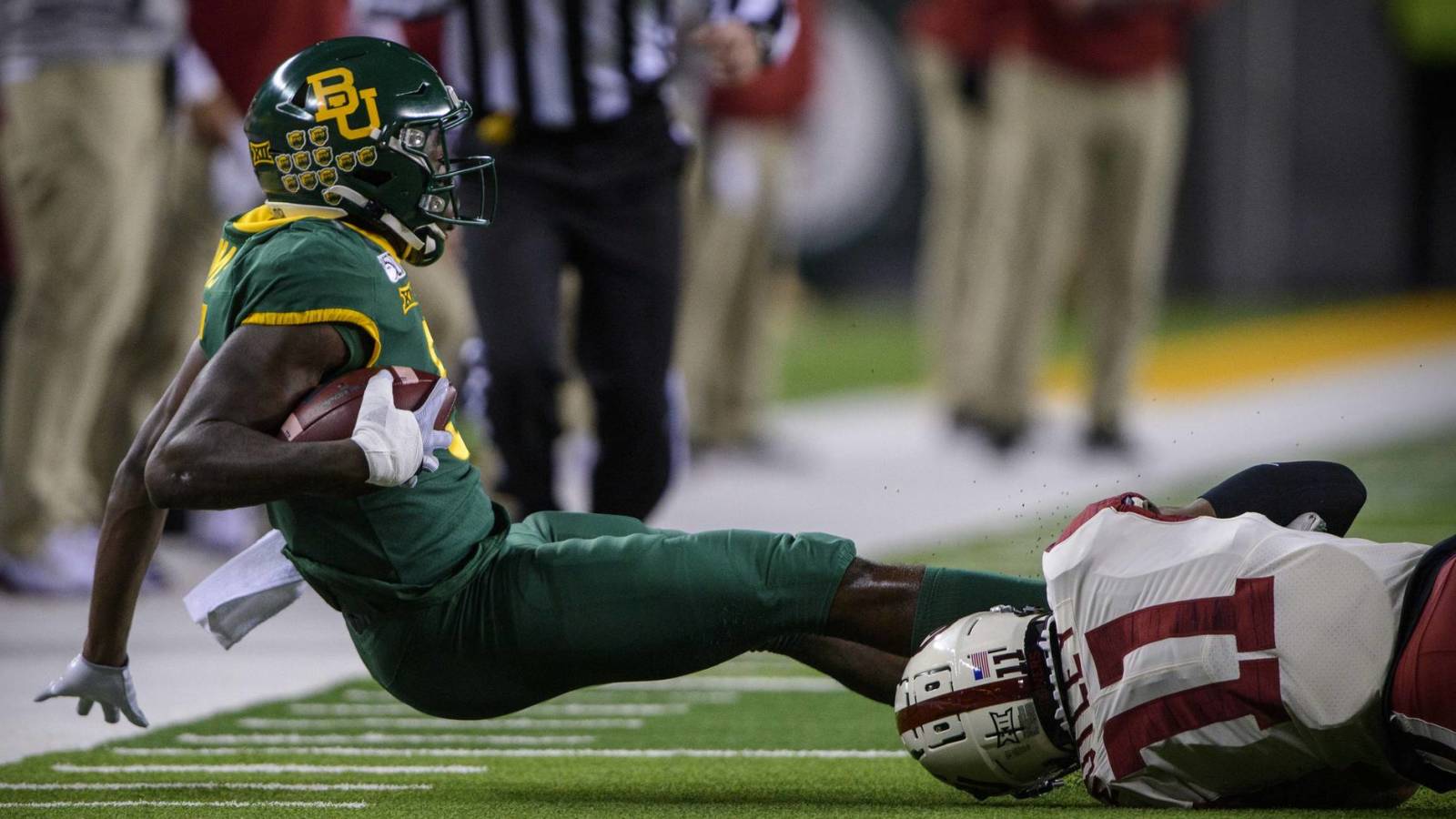
28. New York Jets
An again-abysmal offensive line was as an obvious factor in the Jets’ 31st-place DVOA ranking last season. But Le’Veon Bell went from 129.8 scrimmage yards per game with the 2017 Steelers to 83.3 in his Jets debut. After an O-line overhaul, the former All-Pro RB should be better. But with his guaranteed money done after 2020, this is likely it for Bell in New York.
The Jets replaced Robby Anderson with Breshad Perriman, a late-bloomer who averaged 17.9 yards per catch as the Bucs’ WR3, and drafted Denzel Mims in Round 2. Mims will attempt to buck a troubling trend of Baylor wideout busts. At least QB Sam Darnold still has steady slot receiver Jamison Crowder.
27. Chicago Bears
Chicago currently has nine tight ends, which seems high. One is Jimmy Graham, who received a stunning two-year, $16M deal after showing further decline in Green Bay. Another is second-rounder Cole Kmet, the top tight end in this year’s underwhelming class. The Bears employ solid WR1 and a quietly emerging slot, respectively, in Allen Robinson and Anthony Miller but need more from a run game that ranked 29th in DVOA last season. Diminutive gadget talent Tarik Cohen produced 500 fewer scrimmage yards last season than he did in 2018, and rookie runner David Montgomery did not impress much in Year 1.
26. Detroit Lions
Matthew Stafford is healthy again and has near-household-name Kenny Golladay in a contract year -– after an 11-touchdown season largely with one of the worst QB situations –- and Marvin Jones remaining consistent enough to play out a five-year deal. Detroit has not ranked in the top half of the league in rushing since Barry Sanders’ 1999 retirement and drafted a fourth second-round running back in 10 years in Georgia’s D’Andre Swift. Top-10 tight end pick T.J. Hockenson did little after a breakout first game, but tight ends are notoriously slow developers as rookies.
25. Green Bay Packers
Real-life standpoint: No one should feel bad for a $33.5M-per-year quarterback. Through a sports lens: yikes. Aaron Rodgers took a team with one 500-yard receiver to 13 wins and the NFC title game. The Packers responded by signing slow-footed receiver Devin Funchess, who is coming off a season-nullifying injury, and drafting running back (A.J. Dillon) in the second round despite employing breakout back Aaron Jones.
The Packers did not draft a wide receiver, leaving Davante Adams essentially by himself again, but did draft a quarterback in Round 1. Scouts Inc. did not rate Packers third-round tight end Josiah Deguara in its top 300 players. Not ideal.
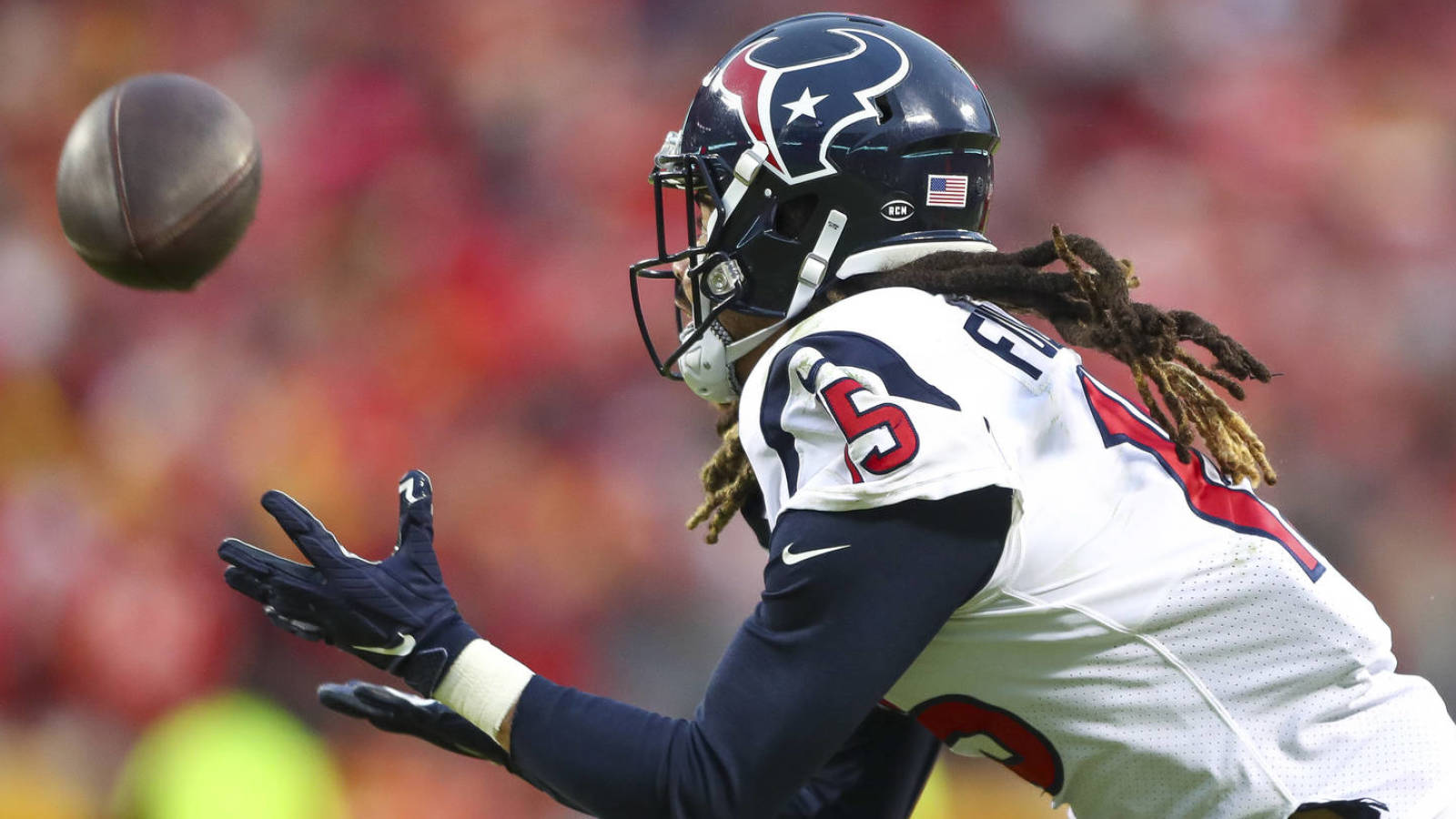
24. Houston Texans
In a Texans dream scenario, head coach-GM Bill O’Brien’s trades will bring 2016-level RB David Johnson and a concussion-free WR Brandin Cooks. Neither player was remotely on this plane last season, but O’Brien paid full price for their lavish contracts in trades. The Texans dealt the third-best player in franchise history, DeAndre Hopkins, to Arizona. Deshaun Watson has not played without Hopkins yet. Seeing how he adjusts will be critical to Houston’s hopes at salvaging this season. With Watson’s QBR 15 points higher with Will Fuller on the field, it would seem Kenny Stills is the trade chip after the Texans signed Randall Cobb.
23. Los Angeles Rams
Robert Woods and Cooper Kupp each surpassed 1,100 receiving yards last season. They joined only Chris Godwin-Mike Evans and Amari Cooper-Michael Gallup as 1,100-yard duos. The Rams added Florida’s Van Jefferson in Round 3, but he will turn 24 this year and never surpassed 700 yards receiving with the Gators.
Cam Akers followed Dalvin Cook as Florida State’s running back and churned out two 1,000-yard seasons despite lesser Seminole offensive lines. Tyler Higbee flashed near the end of the season, however, and a Rams offense post-Todd Gurley and Brandin Cooks needs more from him and fellow tight end Gerald Everett. But this group has taken a major hit since qualifying for Super Bowl LIII.
22. Seattle Seahawks
The Seahawks employ perhaps the NFL’s second-best quarterback and finished fourth in pass-offense DVOA. Russell Wilson still oversaw an offense that ran the ball the third-most times (481). Low-cost wideout Phillip Dorsett and 35-year-old tight end Greg Olsen join Tyler Lockett and surprisingly quick study D.K. Metcalf as Wilson’s top aerial options. Rashaad Penny averaged 5.7 yards per carry last season and should carve out a bigger pie piece from Chris Carson. That notwithstanding, will this finally be the year offensive coordinator Brian Schottenheimer plans game scripts more in line with Wilson’s stature?
21. Minnesota Vikings
The Vikings will tab first-rounder Justin Jefferson to replace Stefon Diggs. Jefferson posted 1,540 yards and 18 TDs as a junior at LSU, when he played 99% of his snaps in the slot. The Vikings need him to be a quick study in Gary Kubiak’s run-oriented offense, because the gulf between Adam Thielen and the rest of Minnesota's receiver holdovers remains massive.
RB Dalvin Cook is playing for a contract but has run into injury trouble in each of his three years. Alexander Mattison looked explosive as a rookie, potentially serving as a cheap successor and Vikings leverage against Cook. Kyle Rudolph is not exciting, but the 10th-year tight end may be needed more post-Diggs.
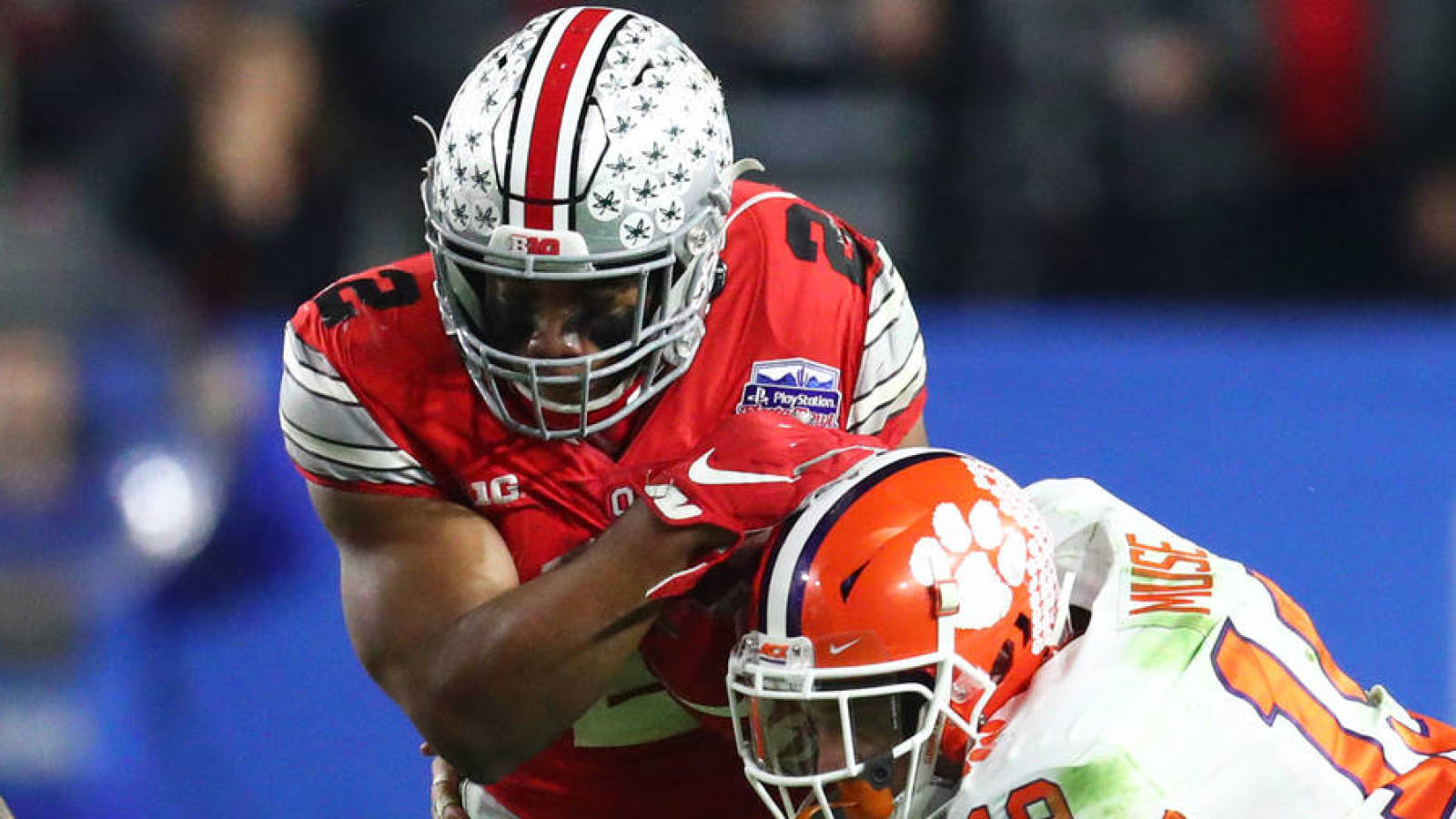
20. Baltimore Ravens
Lamar Jackson has experienced issues involving his wide receivers but has turned 2018 third-round tight end Mark Andrews into a player good enough to allow Baltimore to trade 2018 first-round tight end Hayden Hurst. Coming off their NFL-record 3,296-yard rushing season, the Ravens eschewed other needs to add Ohio State 2,000-yard rusher J.K. Dobbins in Round 2. Jackson, Dobbins, 30-year-old Mark Ingram and yards-per-carry producer Gus Edwards form one of the deepest backfields in modern NFL history.
Marquise Brown still fronts Baltimore’s wideout corps, which added 5-foot-11 third-rounder Devin Duvernay. But the latter only stood out during one Texas season. The Ravens' moves make no secret teams will have to prioritize stopping their cutting-edge run game.
19. Tennessee Titans
No team matches the Titans’ Derrick Henry weapon, and 2019 second-rounder A.J. Brown has a star ceiling. But the Titans must get more from former No. 5 overall pick Corey Davis, who averaged just 40.1 yards per game after headlining a limited Marcus Mariota-conducted attack in 2018. The Titans also did not do much to justify their $9M-per-year Adam Humphries contract. The ex-Buccaneers slot man dropped from 76 catches in a crowded 2018 Tampa Bay offense to 37 with what should have been a more defined Titans role. Tennessee smartly drafted a running back -– Appalachian State’s Darrynton Evans -– to hopefully spell Henry more than Dion Lewis did.
18. Las Vegas Raiders
Boldly drafting Henry Ruggs over safer bets Jerry Jeudy and CeeDee Lamb, the Raiders will count on Derek Carr to find this class’ premier deep-ball maven rather than continuing his avoidance of long-range strikes. Tyrell Williams’ 2020 money is guaranteed, but the ex-Charger and would-have-been Antonio Brown sidekick saw the Raiders draft second- and third-round wideouts –- gadget type Lynn Bowden Jr. (Kentucky) and possession target Bryan Edwards (South Carolina). Receiver Hunter Renfrow fared well as a rookie and should not be concerned about losing his job.
The Raiders’ offense will still run through Josh Jacobs and Darren Waller, one of the top breakout tight ends of recent memory.
17. Indianapolis Colts
Added to Philip Rivers’ new stable: second-round wideout Michael Pittman Jr. and the latest Wisconsin rushing-yardage machine, Jonathan Taylor. Pittman’s 6-foot-4 frame pairs well with the smaller T.Y. Hilton, but the Colts need slot production. They will be counting on 2019 second-rounder Parris Campbell, a Ohio State talent who slogged through an injury-marred rookie slate, in that capacity.
Also a second-rounder, Taylor (6,174 college yards) may cut into Marlon Mack’s extension hopes but gives the Colts a dynamic tandem behind one of the NFL’s best offensive lines for 2020. Two-time Pro Bowler Jack Doyle fronts the Colts’ tight end corps. This is not quite Rivers’ Chargers setup, but the Colts improved from 2019.
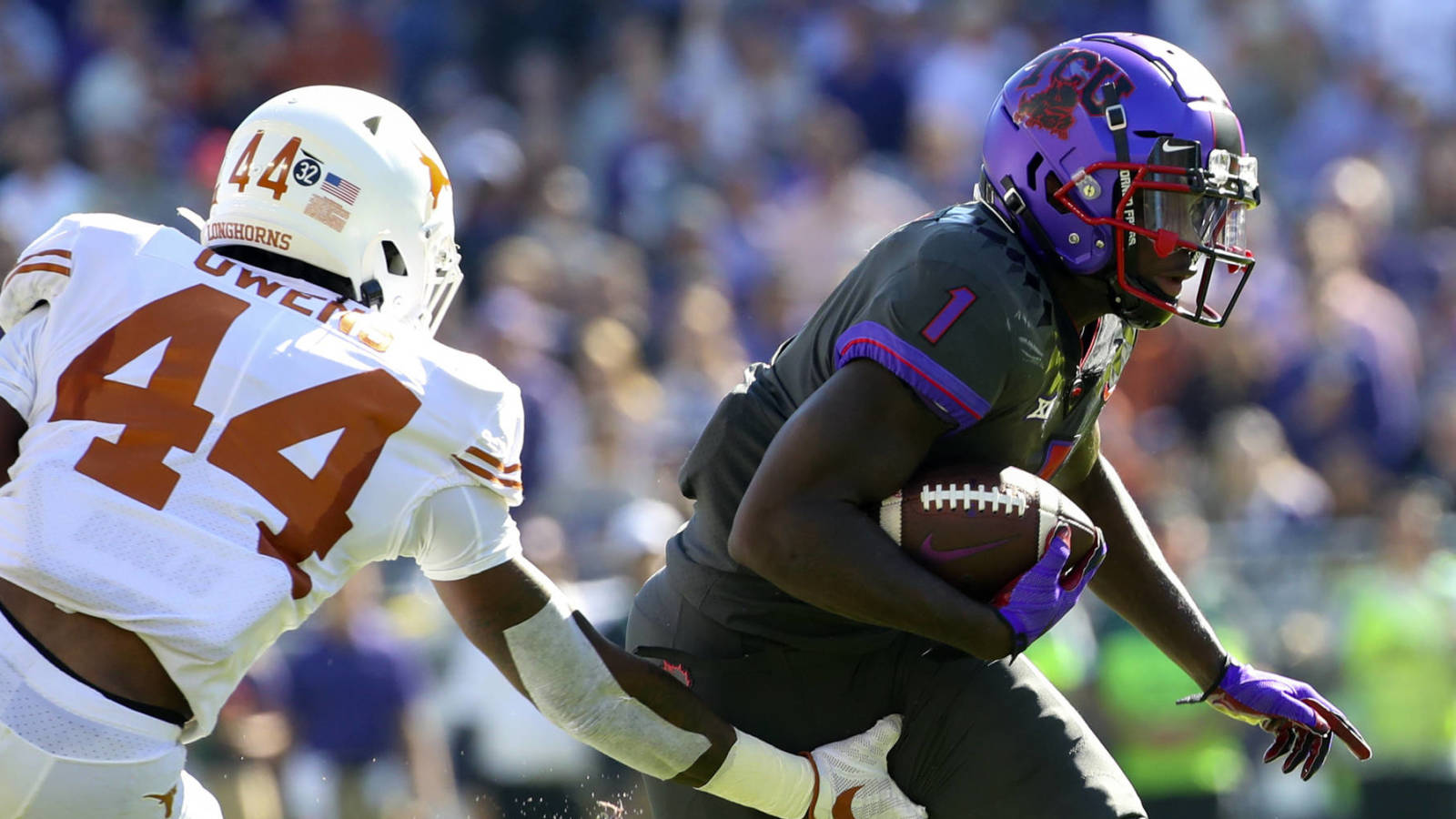
16. Philadelphia Eagles
Not quite on the Travis Kelce-George Kittle TE level, Zach Ertz is close and spearheads an Eagles passing attack with many questions. For now, both Alshon Jeffery and 33-year-old deep target DeSean Jackson reside on the roster. Their contracts will be hard to trade but both battled injuries in 2019. The Eagles added TCU speed threat Jalen Reagor, ex-Olympic long jumper-turned-49ers bench occupant Marquise Goodwin along with fifth- and sixth-round wideouts. Ertz backup Dallas Goedert remains in this mix. With Philadelphia not drafting a running back, Miles Sanders (4.6 yards per carry as a rookie) has the backfield keys.
15. Cincinnati Bengals
Joe Mixon somehow totaled 1,137 rushing yards behind one of the NFL’s worst offensive lines last season and enters a contract year. This ranking, however, only applies if A.J. Green plays. The seven-time Pro Bowl wideout has missed 23 of Cincinnati’s past 24 games. The Bengals franchise-tagged him in order to help Joe Burrow, and a Green-fronted corps with WR2 Tyler Boyd, 6-foot-5 youngster Auden Tate and second-round deep threat Tee Higgins is a strong group. If former top-10 pick and 4.2 40-yard talent John Ross can stay healthy, this is a super-deep receiver corps.
14. Pittsburgh Steelers
A positive development from a rough Steelers season: James Washington and rookie Diontae Johnson improved as last year progressed. The deep threat and shorter-range target combined for over 1,200 yards. With JuJu Smith-Schuster posting 1,426 during Ben Roethlisberger’s last healthy season and now playing for a contract, the Steelers are (yet again) well-equipped at receiver. Second-round wideout Chase Claypool, all 238 pounds of him, further strengthens a pass-catching group that also has recently signed tight end Eric Ebron. But with Pittsburgh not drafting a running back, the suddenly defense-powered team will need more from James Conner in his contract year.
13. Denver Broncos
If the Broncos cannot augment Phillip Lindsay’s pay, pairing him with the less explosive Melvin Gordon may be untenable. Gordon (1-for-5 in 1,000-yard rushing seasons) signed a two-year, $16M deal; Lindsay (2-for-2) is set to make $750,000 this season. On the field, however, that duo would be effective.
But the Broncos' draft work will drive offseason hype. In addition to emerging boundary playmaker Courtland Sutton and 2019 first-round tight end Noah Fant, Drew Lock now has two space-creating wideouts -- each appropriate complements for Sutton's skill set. First-rounder Jerry Jeudy was one of the best route-runners to come through college football in years, and second-rounder K.J. Hamler has game-breaking speed from the slot.

12. Atlanta Falcons
Todd Gurley was the NFL’s best running back from 2017 until December 2018, but the knee problem that surfaced at that point hijacked his career. Gurley averaged 4.2 yards per touch last season for the Rams -– well off his numbers from his All-Pro ’17 and ’18 slates. Despite replacing upper-middle-class tight end Austin Hooper with less productive ex-first-rounder Hayden Hurst, Atlanta ranks in the upper echelon because of future Hall of Famer Julio Jones and ascending sidekick Calvin Ridley. The latter’s 66.6 yards per game represented a 15-yard increase from his rookie season.
11. Buffalo Bills
Given better receivers in John Brown and Cole Beasley, Josh Allen progressed from Year 1 to Year 2. The Bills’ Stefon Diggs trade will complement their outside and slot targets, respectively, and give the team a more qualified player atop their pecking order. Diggs may not be pleased with Allen’s accuracy compared to Kirk Cousins’, but he’s a low-end WR1 on a manageable contract and should help Buffalo’s offense climb from the No. 21 DVOA finish of 2019. Third-round pick Zack Moss will replace Frank Gore as Devin Singletary’s backfield mate. The elusive Utah product rated as Pro Football Focus' No. 2 overall back but was the ninth selected.
10. New York Giants
Still perhaps the NFL’s most talented running back, Saquon Barkley is the top candidate to eclipse Christian McCaffrey’s $16M-per-year contract. The Giants feature a solid, if second tier, receiving tandem in Sterling Shepard and Golden Tate. Darius Slayton emerged quickly despite his fifth-round status last year and may make this Tate’s second and final Giants season. Evan Engram cannot exactly be counted on, with the tight end having missed 13 games over the past two seasons, but he remains a potent weapon when available.
9. Carolina Panthers
Despite amassing only 1,086 scrimmage yards as a rookie in 2017, Christian McCaffrey leads the NFL by over 400 yards during his three-year career. Run CMC will be vital for new QB Teddy Bridgewater, who has been known to check it down from time to time. The Panthers have given Bridgewater a more complete receiving corps than Cam Newton had, signing ex-Jets deep threat Robby Anderson to go with the underappreciated D.J. Moore, who went from 49.3 yards per game to 78.3 last season. If he is not traded, Curtis Samuel (627 yards last year) is a solid WR3 for coordinator Joe Brady's offense.
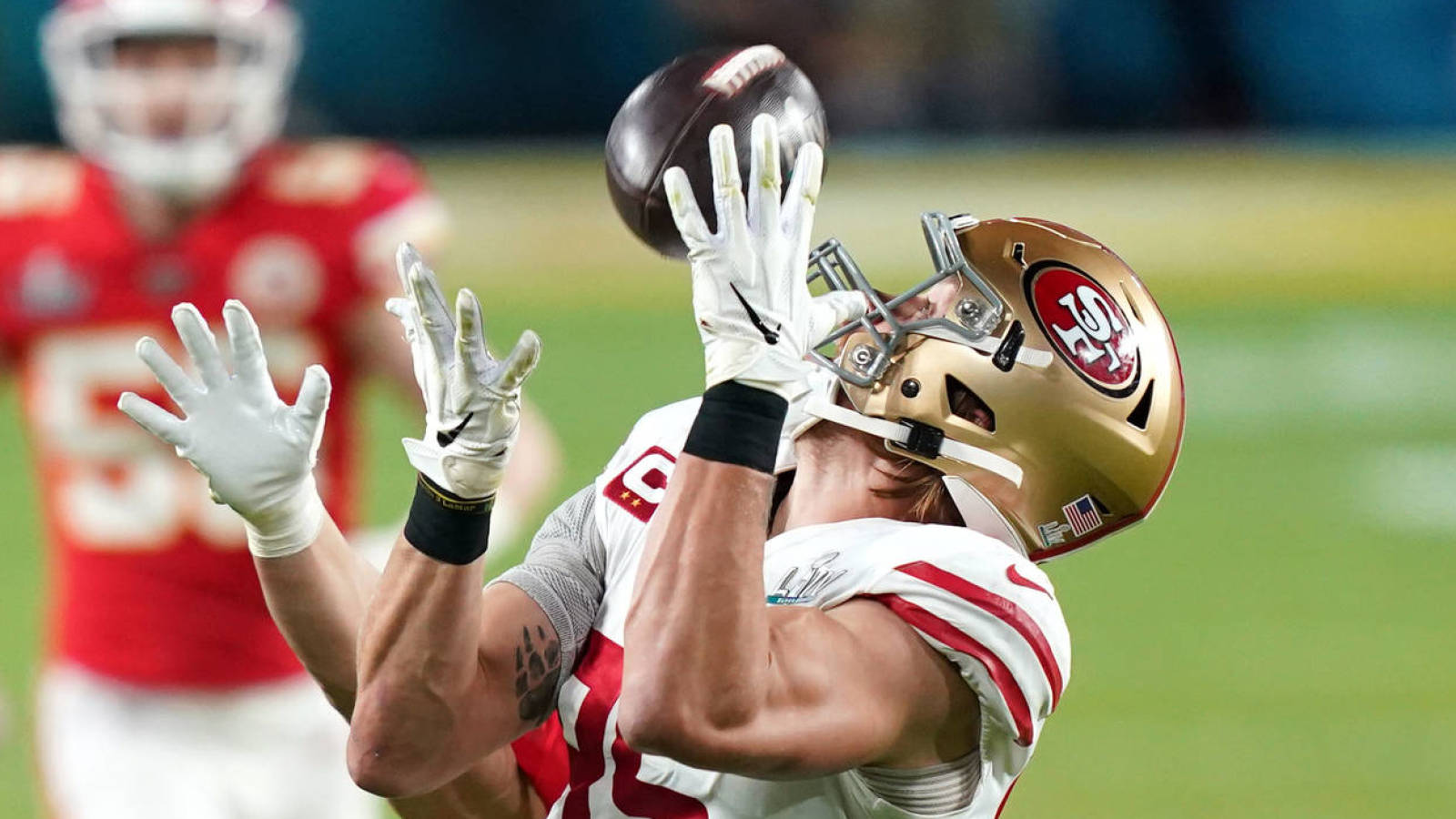
8. San Francisco 49ers
Because George Kittle is an NFL unicorn -– a dominant blocking and receiving tight end -– he raises the 49ers’ place here. Kyle Shanahan also has a first-round wide receiver (Arizona State’s Brandon Aiyuk) joining 2019 versatile second-rounder Deebo Samuel. Aiyuk shares Samuel’s post-reception elusiveness, but the 49ers may need to be patient with the one-year Arizona State impact player. Although ex-Viking Jerick McKinnon has missed two full seasons, his redone contract paves a path for him to join Tevin Coleman and special-teamer-turned-one-cut machine Raheem Mostert in San Francisco’s backfield.
7. Arizona Cardinals
Pilfering DeAndre Hopkins from the Texans will allow the Cardinals to transition Larry Fitzgerald into a complementary role. With Fitzgerald capable of working anywhere across the formation, Hopkins has his best wideout mate since Andre Johnson in the mid-2010s. Fitz and 2018 second-rounder Christian Kirk as Nos. 2 and 3 wideouts raises the floor for Kliff Kingsbury’s second NFL offense. Transition-tagged back Kenyan Drake averaged 80.4 yards per game in eight Cards contests; he topped out at 40.4 in a full Dolphins season.
6. Los Angeles Chargers
Failing to woo Tom Brady, the Chargers may not boast a high ceiling for their skill-position assortment. But they still employ one of the best. Correctly going with Austin Ekeler and a draft pick (UCLA fourth-rounder Joshua Kelley) over a Melvin Gordon overpayment at running back, the Chargers had room to use their franchise tag on tight end Hunter Henry.
Ekeler’s 92-reception, 993-yard season did not receive enough attention, but he will be critical when rookie QB Justin Herbert takes the reins. So will elite route runner Keenan Allen, who has played 48 straight games since his early-career injury crises. Allen’s mid-range game complements 6-foot-4 boundary target Mike Williams, who averaged an NFL-best 20.4 yards per catch in 2019.
5. Dallas Cowboys
Due respect to Raiders-era Michael Crabtree, but Amari Cooper has not played with a receiver talent like first-round pick CeeDee Lamb. The Oklahoma star profiles as a smaller DeAndre Hopkins with superior after-the-catch chops, averaging 11 yards after the catch as a junior –- a top-five Division I-FBS mark last year. Cooper and Lamb will open the field up for Michael Gallup, who had one of the quietest 1,100-yard receiving seasons in NFL history last season. RB Ezekiel Elliott will benefit too; so will recently extended tight end Blake Jarwin, who will be a full-time starter for the first time.
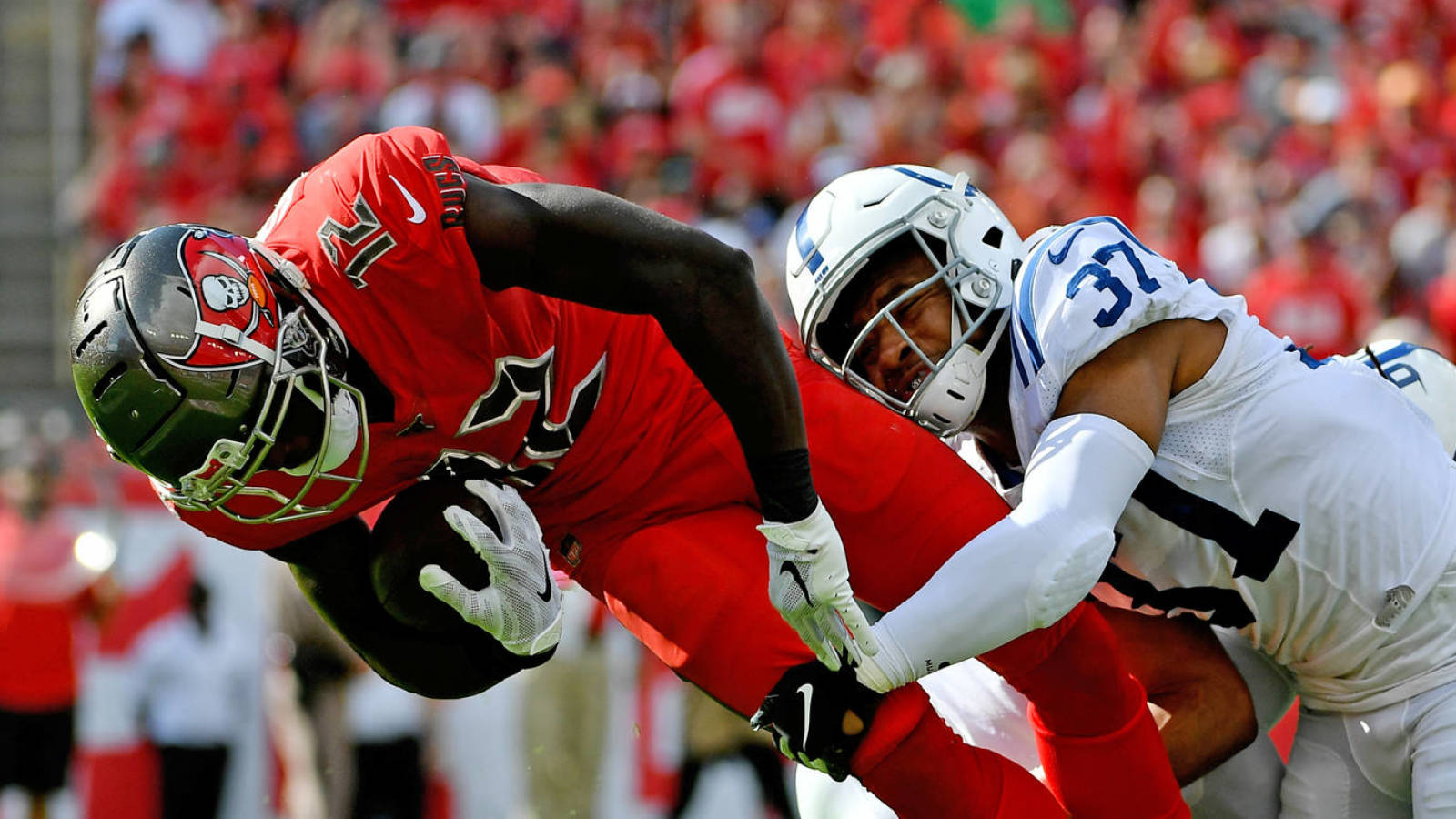
4. Tampa Bay Buccaneers
Chris Godwin vaulting from 52.6 yards per game as Tampa Bay’s WR3 in 2018 to 95.2 last season provided a strong selling point for Tom Brady. Mike Evans joining Randy Moss as the only other player to start their careers with six straight 1,000-yard seasons probably helped too. For now, both the underused O.J. Howard and high-profile No. 3 tight end Cameron Brate remain Bucs. It might make sense to keep both, with Rob Gronkowski having retired due to health concerns 13 months ago. But Gronk at 75-80% of his dominant 2011-17 version is still a difference-making weapon. Third-round running back Ke’Shawn Vaughn should provide the Bucs with a higher-upside wingman for Ronald Jones than Peyton Barber did.
3. Cleveland Browns
The Browns will give their Odell Beckham Jr.-Jarvis Landry duo another chance. After overseeing Adam Thielen and Stefon Diggs in Minnesota, Kevin Stefanski is more qualified to unleash a duo of 27-year-olds with eight combined Pro Bowls than the overmatched Freddie Kitchens was. Nick Chubb and Kareem Hunt are overqualified to play together and now will run behind an offensive line with two impact tackle additions.
Cleveland can afford new tight end Austin Hooper’s $10.5M-per-year contract during Baker Mayfield’s rookie deal. Despite a technical demotion, 2017 first-round tight end David Njoku will still see steady work in Stefnaski’s preferred two-tight end looks.
2. New Orleans Saints
The lack of a Michael Thomas sidekick marked one of the Saints' few weaknesses the past two years. Emmanuel Sanders’ two-year, $16 million deal will bolster a Saints offense that has not ranked outside the top 10 during the Sean Payton-Drew Brees 14-year partnership. Appropriately cast as a WR2 at age 33, Sanders has the ability to play outside and in the slot and could make New Orleans nearly impossible to stop with RB Alvin Kamara and Jared Cook back. Kamara and Thomas rank fifth and sixth in scrimmage yards from 2017-19. The latter’s record 149 receptions led all wideouts by 45 last season.
1. Kansas City Chiefs
The Chiefs ranked 23rd in rushing last year and had not fully replaced Kareem Hunt. First-round pick Clyde Edwards-Helaire may not have represented great value for a team needier on defense, but the LSU RB broke 70 tackles last season and caught 55 passes. With Andy Reid labeling him as an evolved version of ex-Eagle Brian Westbrook, that is a stop-in-your-tracks moment considering Patrick Mahomes already has All-Pro tight end Travis Kelce and a receiver troika that includes all-time speed merchant Tyreek Hill, a younger Hill version (Mecole Hardman) and Sammy Watkins.
More must-reads:
- Ranking each team's QB situation after the NFL Draft
- Way-too-early 2021 NFL mock draft
- The '100 catches in an NFL season' quiz
Breaking News
Customize Your Newsletter
 +
+
Get the latest news and rumors, customized to your favorite sports and teams. Emailed daily. Always free!

